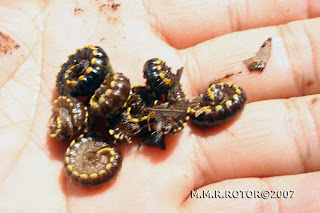12 Oddities in Nature
Are you familiar with these natural oddities?
Dr Abe V Rotor
1. Porcupine, real specimen or hand crafted?
2. Fruits are produced not from flowers, but directly
from special buds. What tree is this? Does its seed
8. It's tough, it grows radially, and clings on dead
trunk like shelf.
9. It's all skin, its owner makes the loudest and
longest love song among trees.
It feigns dead curling into a wheel with its soft belly
of mimicry, you might miss it among the leaves
and stems of its host tree.
mollusk, which gave the concept of a prototype submarine
in Jules Verne's Twenty Thousand Leagues Under the Sea.
Answers:
1. It's real. The porcupine is indigenous to Palawan. It is now in the list of highly endangered species.
2. Siniguelas ( sarguelas Ilk) - Spondias purpurea. This is exemption to the rule that fruits and seeds are products of pollination and fertilization. Siniguelas can't be propagated by seed, it is by cuttings. Just cut a good branch, the girth of a man's arm, a meter or two in length and plant it on well drained loam soil. Plant along fences and field borders.
3. Edible sea urchin (maritangtang Ilk), an aphrodisiac.
4. Native kuhol. An hermaphrodite has both gametes - sperm and egg. Seldom does fertilization and zygote formation take place in the individual. Copulation is necessary to prevent inbreeding. Exchange of genes is necessary. During mating, the first to penetrate is the male. At another time, it plays the role of female.


5. Icon of a Paulinian sister, at the former St Paul University Museum QC, reading the Holy Book.
6. Growths are not of plants but saprophytes (tainga ng daga or Auricularia) and lichens (association of algae and fungi).
6. Growths are not of plants but saprophytes (tainga ng daga or Auricularia) and lichens (association of algae and fungi).
7. It will become fossilized. If embedded in resin, the fossil will be visible through the clear amber.
8. Shelf mushroom, a polypore (many pores) fungus.
9. Cicada. It's the male that sings; the female is mute.
10. Millipede, Class Diplopoda, relative of the insects and spiders, centipedes - they all belong to Phylum Arthropoda.
11. Walking stick, originally classified under Orthoptera, the order of insects
12. Nautillus. The fictional submarine in the novel is named after this livbing marine fossil. The captain in Nautillus is Captain Nemo. ~













No comments:
Post a Comment